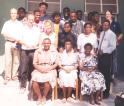32 photos.
 House 16, Ponhofi School
House 16, Ponhofi SchoolOhangwena, Namibia, 1997
I stayed in this house in late 1995 with Liam Garvey from Australia.
 child outside a tin house
child outside a tin houseOniipa, Namibia, 1995
Because of the recent population boom, deforestation has limited the amount of available wood (mostly from omusati/mopane trees) for fencing and housing. As a result, a more Western style of housing has been adopted: rectangular houses made of metal or concrete, with wire mesh for fencing. These houses are hotter and costlier, but they are more permanent, they save wood, and their modernity makes them a status symbol. A volunteer teacher I knew lived in a traditional compound in a hut with walls made of cement interspersed with hundreds of empty dumpies (beer bottles) to act as tiny windows of light. Another volunteer helped to stock a dumpie library with books. Tin buildings are very commonly seen on roadsides, often serving as bottle stores (bars).
 Class 11C, Ponhofi School
Class 11C, Ponhofi SchoolOhangwena, Namibia, 1995
Most of the girls were in the required uniform most of the time, but the boys preferred to pretend to be rebels. In many schools, students cannot afford to buy a uniform, but at Ponhofi this was mostly a false excuse. The students were generally friendly, polite and well-behaved. They tried incredibly hard, despite their limited exposure to English, so although the teachers did not enforce discipline well, they usually did not have to. Most students came from rural farms, yet they hoped to get a job in a town or city, where the competition for white-collar jobs is stiff.
 100-yard dash on the football (soccer) field, Ponhofi School
100-yard dash on the football (soccer) field, Ponhofi SchoolOhangwena, Namibia, 1995
Sport and recreation facilities are very limited in rural areas in the North. Sports shoes and uniforms are luxuries that few schools or students can afford. Also, it must be difficult to be an athlete considering the low amount of calories in the diet provided by the hostel cafeteria. Yet some of the boys appeared to have great potential. Sports for girls are not considered very important.
 staff, Ponhofi Senior Secondary School
staff, Ponhofi Senior Secondary SchoolOhangwena, Namibia, 1995
The teachers and staff at Ponhofi were a great team and fun to work with. They were a culturally and linguistically diverse group. Ponhofi had more volunteers than most schools and was relatively overstaffed (average teacher class load was *only* 25 to 30 hours per week out of 40, and average class size was about 35). The cities and relatively nice schools like Ponhofi attract the best teachers and students, so there is a very unequal distribution of talent.
 mural
muralWindhoek, Namibia, 1995
Murals are a popular form of art in urban Namibia and South Africa, especially around the time of independence and the end of Apartheid. This mural represents the diversity of Namibia's flora and fauna.
 mine field
mine fieldOhangwena, Namibia, 1995
I passed this mine field every time I walked from the dining hall to the post office. Large armored trucks would drive through the mine fields and set off mines around lunch time. The border between Namibia and Angola remains fairly heavily mined, and many people, especially children, continue to be killed or injured by mines long after the end of the war. Children think the mines are toys and pick them up. An education and de-mining campaign has helped somewhat, but it is much more expensive to de-mine than to mine. The US continues to be one of the few countries that refuses to sign the international treaty banning land mines.
 souvenirs on Post Street Mall
souvenirs on Post Street MallWindhoek, Namibia, 1995
Souvenirs for sale include baskets, wood bowls and animal carvings, necklaces, and drums, most of which are made in the North. Downtown in the capital city is very similar to a European city: modern, clean, and many rich people. When you go to the suburbs you see the poor people in small houses crammed into dusty lots. During the Apartheid era, non-whites were driven into the suburbs, and though the law has changed, the inequalities are slow to go away.
 fence and shelter inside a traditional homestead
fence and shelter inside a traditional homesteadOniipa, Namibia, 1995
A traditional Owambo homestead was a large maze of wooden fences surrounding a group of round wood huts with thatched roofs and sand floors, each of which served a different purpose (bedrooms, grain storage, kitchen, social quarters, etc.) Wealthier farmers now own cars or bakkies (pickup trucks).
 my first house, Ponhofi School
my first house, Ponhofi SchoolOhangwena, Namibia, 1995
I shared this house with Adams Kamulegeya, a Ugandan maths teacher I later met by chance in Mutukula in 2003, his Owambo wife Letu, their newborn baby, and some chickens (who had the biggest room). It was a modern concrete house with a metal roof, and electricity and running water (most of the time).
 goat
goatOhangwena, Namibia, 1995
This goat was slaughtered for a party held by a British volunteer. Goats and cows are a common source of meat in the North, and goat meat tastes good when properly seasoned and cooked.
 ferry
ferryZanzibar, Tanzania, 1995
We took a ferry like this to get to the island. It only took about an hour, but it cost about as much as a three-day train trip to Zambia.
 columns
columnsZanzibar, Tanzania, 1995
The influence of the highly advanced Swahili culture has extended up and down the coast of East Africa for several centuries. They traded with people of distant lands, sailing on the Indian Ocean in dhows.
 door, Zanzibar Town
door, Zanzibar TownZanzibar, Tanzania, 1995
Zanzibar town is a picturesque Islamic city with narrow streets, ornately carved doorways, and centuries-old buildings which are being restored. It is becoming a major tourist destination in Africa.
 mosque entrance, Zanzibar Town
mosque entrance, Zanzibar TownZanzibar, Tanzania, 1995
The Swahili people are Muslims; their language is a mix of Arabic and Bantu languages, and can be written in either Arabic or Western characters. Millions of people from several countries in east and central Africa speak Swahili.
 National Museum, Zanzibar Town
National Museum, Zanzibar TownZanzibar, Tanzania, 1995
The Zanzibar National Museum includes many fascinating items from the Swahili and colonial eras.
 cow and hut
cow and hutZanzibar, Tanzania, 1995
The island's main industries are tourism and agriculture. Many kinds of spices are grown on the island for exporting.
 tortoise, Prison Island
tortoise, Prison IslandZanzibar, Tanzania, 1995
Prison Island is a short boat trip from Zanzibar town. There we saw the ruins of the prison, swam and snorkeled above the coral reefs. It is easy to find these large tortoises on the island. They move very slowly; the big ones must weigh over 200 kg.
 sycamore fig tree
sycamore fig treeOndangwa, Namibia, 1995
The north has some very large trees that provide shade even in the dry season. In the rainy season, this tree is surrounded by water.
 Makalani palm tree
Makalani palm treeOhangwena, Namibia, 1995
As you drive north towards Ondangwa, you are suddenly surprised by the appearance of these tall trees, which are an indicator of a relatively wet rainy season and of large underground water reserves. Ovambos use every part of the tree, which they call omulunga, e.g. the trunk for stools and cattle troughs, fronds for weaving baskets, eendunga (palm nut fruits) for food and oil, and sap for producing palm wine. Wood of other trees is used for housing, fencing, firewood, furniture, cups, bowls, buckets, fish traps, handles and weapons.
 flamboyant tree
flamboyant treeMorogoro, Tanzania, 1995
The red buds of Flamboyant trees are a common sight in southern Africa and add colour to the surroundings.
 tree roots, Changuu (Prison) Island
tree roots, Changuu (Prison) IslandZanzibar, Tanzania, 1995
For me, this picture symbolizes the idea that African roots run deep. Once you live there, you cannot forget your memories and responsibility to your friends and family there. You know that one day you will return. (Changuu Island used to be a prison; now it is inhabited by snorkelling tourists and giant tortoises.)
 spiraling palm tree
spiraling palm treeZanzibar, Tanzania, 1995
Compared with those in Namibia, the trunks of palm trees on Zanzibar island are very tall and thin. The wind may have caused this tree to grow in a corkscrew shape.
 baobab tree
baobab treeVictoria Falls, Zimbabwe, 1995
Baobab trees are common throughout Africa and can be found in the northern part of Namibia, where they are known as omukwa. They can live for hundreds of years. This one is very old and has a trunk of about 10 metres across. The San use many parts of these trees.







